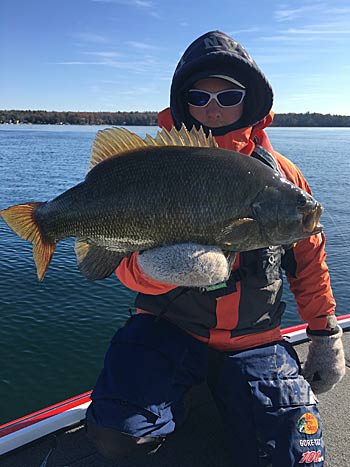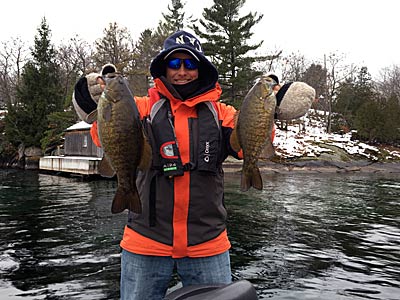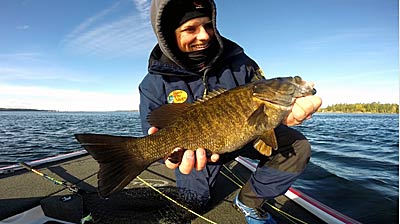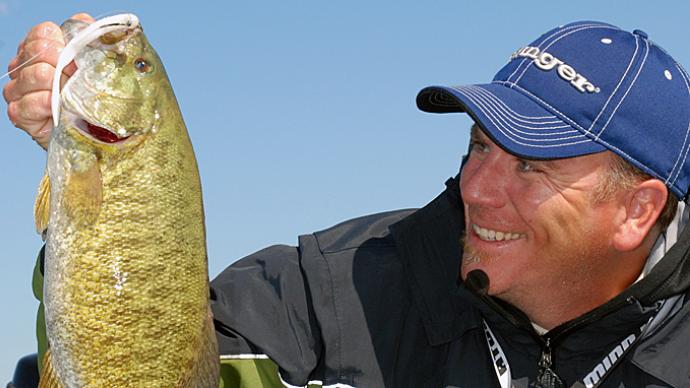
When you live in smallmouth country, summer can turn into fall and winter in what seems like a blink of an eye. It’s not unusual to be basking under a warm sun one day and brushing snow from the boat cover the next. But during that transition, before the boats are put to bed until spring, there’s an opportunity to catch smallmouth in shallow water one last time.
Brad Paradis fishes that transition yearly on his home water — the St. Lawrence River in extreme northern New York. “The great thing about fall time is you can fish the river anyway you want,” he said. While he likes to catch them from deep water like the next angler, a shallow fall bite, which happens everywhere that smallmouth swim, is a special time.
Why it happens
Paradis, who competes on the Costa FLW Series and is always a threat to win local tournaments on St. Lawrence, said while a few smallmouth stay shallow year-round, most spend much of their time in deep water. The exceptions happen in spring when they spawn and a short time in fall. “I look at our fall in two sections — early fall and late fall,” he said. He finds most smallmouth in deep water — 40 to 50 feet where he’s fishing — about Labor Day. That’s about twice as deep as he usually catches them in summer.
But as the water temperature drops, Paradis said smallmouth start leaving deep water. And by the time it reaches about the mid-50s, sometime in October in his neck of the woods, they’re almost on the bank. “That’s when I see more moving, really super shallow,” he said.
Once the water temperature gets closer to its winter low, Paradis said the shallow water bite shuts off. For example, he said that’s about the 50-degree mark on St. Lawrence. But it’s not a full retreat to the deepest water. First, smallmouth spend some time between 15 and 30 feet. They respond best to a slower retrieve, such as shaking a drop shot or dragging a tube.

At least that’s the case during a typical fall. Extreme conditions can delay smallmouth movements. In 2017 and 2019, for example, Paradis said high water and a cold spring kept most of the St. Lawrence’s male smallmouth on spawning beds and out of deep water through July. Just a few weeks before, he could find 5-pound smallmouth still on spawning beds in 1 foot of water. It can have the opposite effect, too. In between those high-water years, for example, the autumn was warmer than most, he said, and water temperatures were slow to drop. “We missed the late fall bite,” he said. Once cold weather arrived, the smallies made their move, but his season was over.
Whether Paradis wants to stop fishing or not, especially if the weather is cooperating, bass season on St. Lawrence closes on Nov. 30. It doesn’t re-open until the third Saturday in June, according to the state Department of Environmental Conservation regulations. While most of the state continues with catch and release fishing for bass, his corner is exempt from that option.
The easiest way to keep up with smallmouth in the fall is by watching your electronics, particularly the temperature reading. “I think water temperature has a lot to do with the movement of bass,” Paradis said. But temperature isn’t what’s moving them. He said they are following baitfish, forced into schools while seeking what’s left of their preferred water temperature. While the St. Lawrence’s recently introduced gobies, for example, are the target of smallmouth in summer, he said, perch and other small baitfish are what they want in fall. He often finds the remains of recent meals in his livewell. “You rarely see [baitfish] in summer,” he said.
Where to look
The shallow fall bite starts as an early morning deal. Light levels are low, making smallmouth comfortable without much water over their heads. But as the season progresses, more smallmouth head to the shallows and stay longer.
What constitutes a shallow spot depends on the fishery. Those with stained water can be a foot or two. The St. Lawrence River, on the other hand, runs extremely clear. So, shallow spots — mostly points and the tops of humps — may be as deep as 15 feet. Paradis said having deep water — 30 to 40 feet in his case — nearby is the perfect scenario, especially earlier in the fall. That way, smallmouth can take advantage of shallow water hunting with the security of depth close at hand.

Paradis said the best spots have something in common. “I’m looking for any type of flat or point with scattered rock,” he said. For two reasons, there’s more on St. Lawrence the farther downstream you run from Lake Ontario. First, the river is shallower and narrower. Secondly, rock blasted and dug from the river’s bottom during the seaway construction, allowing ships to sail to Great Lakes ports as far west as Duluth, Minnesota, from the Atlantic Ocean, was deposited along the banks and in the river to form islands.
While a mix of aquatic vegetation and rock often produces plenty of shallow-water smallmouth earlier in the summer, Paradis said it’s not much of a player late in the fall. The first strong cold kills much of it, and when that happens, it floats to the surface, making fishing difficult until a stiff wind blows it away. Wind helps in other ways. It riles the surface, making it more difficult for the smallmouth to see you on the other side and your lure under it. That makes them more willing to bite.
Paradis continuously checks certain shallow spots where he has a history. He often finds late fall smallmouth hanging out where he finds them spawning. “A few of my spots I go back and catch were I caught them on beds in June,” he said.
These smallies aren’t loners. Paradis often finds schools of them. “Usually, if you catch one, you’ll run into another,” he said. “You’ll catch one, and four or five will be behind it, trying to pick up the scraps.”
What to throw
Shallow smallmouth are aggressive, primed to chase moving lures that imitate baitfish. “In the fall, I like to throw a spinnerbait,” Paradis said. He covers water and triggers reaction strikes from them with a steady retrieve that burns his lure through the water.
Paradis fishes his spinnerbait fast enough to keep the current from washing it away but not so fast that it runs close to the surface. “You speed up a spinnerbait too fast, and you’re not fishing it the right way,” he said. “I like making a long cast and keeping it down.” Accomplishing that starts with the correct blades. He uses double willow-leaf blades, which produce plenty of flash but not much lift. “Those blades cut through the water,” he said.
Heavier spinnerbaits stay down at speed. Paradis prefers a 1/2-ounce or 3/4-ounce model. He keeps to a few colors: all white or white with a touch of chartreuse or silver and red. He often cycles between them, searching for what smallmouth want on a particular day. He adds a Zoom splittail trailer, matched to the skirt color, and a trailer hook. “Often, they just swipe at the bait,” he said. “Many are caught just on the trailer hook.”
On occasion, Paradis said jerkbaits fished with a rapid-fire retrieve are an excellent alternative to a spinnerbait, but only once floating dead vegetation has disappeared. “You can’t even throw it [before that],” he said.
Paradis builds his setup to generate those reaction strikes. He starts with a 7-foot 2-inch Enigma rod with medium-heavy power, which helps him set the hook. He attaches a high-speed reel featuring a 7:1 gear ratio, which makes it easier to burn his spinnerbaits. He spools it with green 12- or 14-pound test Berkley Trilene XT. Even in the ultra-clear water of St. Lawrence, the slightly larger line doesn’t spook smallmouth. He said they only pay attention to the lure when they are on the feed. And it is a monofilament means it has more to give than braided or fluorocarbon lines. “It has a little stretch, which helps when they clobber it,” he said.




